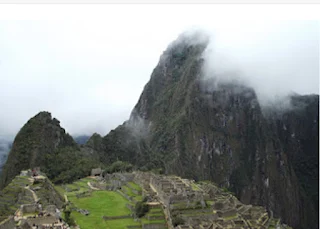Journey to the Ancient & Mystical Land of Machu Picchu
Your journey to Machu Picchu starts in beautiful Cusco, a city high up in Peru's Andes and once the capital of the
Inca Empire.
On the outskirts of Cusco, first catch a bus through the Sacred Valley to Pisac and then to Ollantaytambo. From there you can connect with a Peru-Rail train to the mountain town of Aguas Calientes. Here is the gateway to Machu Picchu; one of the most famous archaeological sites in the world.
Thirty-five kilometres from Cusco, you'll arrive in Pisac, and explore the fascinating Archaeological Park, with its religious structures, terraces and a ceremonial area with spectacular valley views. After you shop-till-you-drop at the buzzing Pisac market, full of handmade crafts and textiles made by local artisans, you will travel further through the Scared Valley to the nearby town of Ollantaytambo. Enjoy the lovely little plaza here that is surrounded by rocky cliffs, and it's the perfect place to sit and watch the world go by. After being conquered in the mid-15th century, Ollantaytambo became part of the Inca emperor Pachacuti's royal estate. The town housed the Inca royalty and nobility while they worked on extensive terracing and irrigation projects in the Urubamba Valley. It still has some of South America's oldest continuously occupied dwellings.
You'll explore the well-preserved Inca terraces, "canchas", which were defended by Manco warriors. It was right here in Ollantaytambo that witnessed some of the last battles against the Spanish conquest. The mountains surround the entire area, with the main Inca access routes running along the Urubamba Valley to Pisac and all the way up to Machu Picchu.
At Ollantaytambo's small railway station, there will be a great atmosphere with the sounds of street vendors cooking popcorn, sweet corn and meat sticks. After a spectacular two-hour train journey, where the Patakancha River meets the Urubamba River, you will arrive in Aguas Calientes. Rows of food vendors and tourist restaurants will welcome you, and also plenty of family run hotels that are affordable and spotlessly clean.
Your alarm will wake you up around 05:30, because it's an early start for the final leg of your journey to Machu Picchu. For the more adventurous, you can hike up to the top through the misty mountains along the trails. Or there is a bus that zigzags through the lush forest.
Paying the entrance fee, you'll be immediately left speechless when you see Huayna Picchu, seen in a million photos. (fingers-crossed there won't be too much low cloud). A trail with large stone blocks that have been precisely cut and aligned lead you through this archeological wonder. Imagine a barefooted messenger running along here six hundred years ago. Machu Picchu, which translates as "Old Peak," was a royal estate and religious retreat built in 1440 by Sapa Inca Pachacuti. Sadly, the city's life came to an end, when Pizarro arrived invading Peru during the Spanish Conquest in 1532. In 1911, Hiram Bingham, an American explorer and young history lecturer from Yale University, discovered the twentieth century's greatest archaeological find.
You'll join a tour group and explore the Sacred District, and the three main primary structures: the Intihuatana "Hitching Post of the Sun", the Temple of the Sun, and the Room of the Three Windows. There is the Royal Mausoleum, the monolithic shrine in the Sacred Plaza, and the mysteriously carved Intihuatana stone. It is fascinating walking through the streets, and admiring the many houses once inhabited by women, children and priests. The structures are built in the traditional Inca style, with granite blocks and polished dry-stone walls. Imagine the Incas walking through the streets and drinking from the water fountains linked by channels and water-drains. Much recent research has focused on how Machu Picchu's buildings were specifically designed to interact with the sun, stars, and surrounding landscape. The most famous example is the Sun Temple, or Torreon, where each year on the winter solstice (21st June in the southern hemisphere), a beam of light shines through a window and forms a mysterious rectangle atop a slab of granite.
Huayna Picchu rises 360 metres above the city. To really feel as though you have fully explored this wonderful place, a hike up to the top is a big reward. Be careful if it has rained, because the near vertical ancient stone steps on the trail can be slippery in places, but ropes offer some support. When you reach the summit, you'll be amazed by the stunning scenery, picture postcard, and the fascinating ancient Temple of the Moon. To walk in the footsteps of the Incas is a truly thrilling experience. A journey to the ancient mystical land of Machu Picchu, The Scared Valley and Cusco is a must-see for any trip to Peru.



